Memory of Darkness / P.A. Brown
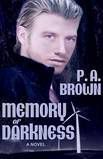 Amber Allure / September 2009
Amber Allure / September 2009
Reviewed by: Rick R. Reed
Synopsis: Johnny Wager has been a loser all his life and proud of it. But when a West Hollywood twink ends up dead in a hotel room with Wager literally holding the bag, he knows his life is going to change for the worse. Pursued by the West Hollywood sheriffs for a murder he knows he didn't commit, Wager has to stay one step ahead of them and prove his innocence. It doesn't help matters any that his own son, Mark Wager, is a deputy sheriff who has joined the manhunt and has more reason than anyone to find the father who failed him all his life and bring him to justice.
Add Hyacinth, a six-foot-five drag queen from New Orleans, Taz, her Puerto Rican boyfriend, an ex-Marine porno filmmaker and his incontinent Basset Hound Columbo, and the Armenian mob chasing them all through the streets of Los Angeles and the art walks and canals of Venice Beach and you have a recipe for one of the most bizarre thrillers to come along in years. Wager pursues his own answers to the question of who is trying to kill him in the sleazy bars and back alleys of Hollywood all the way to Cathedral City.
Can Wager stop the killers and reconcile with his son or will he end up being the next victim? Betrayed by friends, beset by his own conscience that has come back late in life with a vengeance, and the need to redeem himself, he battles the ruthless mob in the only way he knows how: with cunning and a total disrespect for the law.
Review: P.A. Brown is one of those writers who should be as famous as P. Cornwell, if there were any justice in the world. The author of a whole series of competent, well-researched, and catch-your-breath suspenseful thrillers all centered around the seamy (and gay) underbelly of Los Angeles, Brown’s oeuvre is one that should be embraced by anyone who loves a seamlessly plotted thriller with characters that are anything but typical. Brown writes lean, muscled prose and captures the male viewpoint so effortlessly that one wonders how she does it. What is that bulge in your crotch, Ms. Brown?
Memory of Darkness is a bit of a departure for Brown, but not so much that those who have come to love heart-pounding thrillers like L.A. Heat and Geography of Murder will be disappointed. Read the premise above and you might come away with the impression that this is a bit of a madcap adventure, coming down on the side of farce more than suspense. I think Brown herself wants to believe that Memory of Darkness falls more into the genre of comedy than thriller.
But you and Brown would both be mistaken. Memory of Darkness serves up a stay-up-all-night read that grabs you and refuses to let go until its surprisingly touching denouement. In spite of its universe populated with oversized drag queens, impolite hounds, and kinky sex aficionados, this is a book that, for its best intentions, fails at being a comedy…but succeeds brilliantly as a thriller. Part of the reason is that Brown is so adept at assembling a cast of characters that are just as unique as they are sympathetic. Everyone here is someone you probably haven’t encountered in fiction before and Brown imbues them all with the kind of detailed, real-life touches that make you care deeply about most of them, and at least want to see what happens next to all of them, even the most villainous of the lot.
Underlying Brown’s crime tale is a romance between the main character and the owner of the afore-mentioned Bassett Hound…and a very touching story of how family ties can come unraveled. Brown’s main character, a very gay man, has a son on the Los Angeles police force, and their interactions through this story not only make for compelling conflict, but for a real commentary on the importance and complexity of father and son relationships. Brown never makes their relationship easy, but also offers hope for reconciliation, just like in families of the real world.
Memory of Darkness is a light, but gripping, introduction into the world of P.A. Brown. It’s a world if – you’re like me – you won’t want to soon leave.
Purchase Memory of Darkness by P.A. Brown.
Rick R. Reed is the author of ten novels and has short fiction in more than twenty anthologies. He lives in Seattle, WA. Find out more about the author at his website.
Lovecraft Unbound / Edited by Ellen Datlow
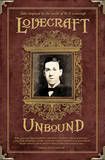 Dark Horse Comics / October 2009
Dark Horse Comics / October 2009
Reviewed by: Blu Gilliand
Let me go ahead and get this out of the way: I’m no fan of H.P. Lovecraft. There. I said it. And while I know this will have many of you grabbing your pitchforks, lighting your torches and heading south to find my house, please understand – I’ve tried. Many, many times. Every few years I’ll take my paperback collection of Lovecraft stories off the shelf and dive in, thinking that this time, with a more seasoned eye and broadened tastes since the last time I tried — this time it will happen. This time I’ll “get it.”
But I don’t. I just don’t. I can’t make it past the (for me) impenetrable prose to get to the meat and heart of what so many others love.
But that’s okay, because I think my inability to “get” Lovecraft makes me the perfect person to review Ellen Datlow’s new anthology Lovecraft Unbound. This may be my ticket in. Because what Datlow wanted out of her contributors was not for them to do their best Lovecraft imitation – instead, she sought stories that were expressions of the authors’ love for Lovecraft. She wanted them to take the things that spoke to them in his writing and express them in their own style.
Many of them succeeded in doing just that. And in doing so, they have opened the door for me to, after all these years, finally understand what all the fuss is about.
Take “The Crevasse” by Dale Bailey and Nathan Ballingrud, for example. In it, a member of an arctic expedition explores a mysterious crack in the ice, populated with strange carvings and the leathery rustlings of unseen creatures. It’s tense and atmospheric, keeping the monster in the shadows so that our imaginations can run wild with it.
Or Brian Evenson’s “The Din of Celestial Birds,” in which a man loses four months of his life when he stumbles across a mysterious stone hovel in the mountains. He goes in to inspect a strange, empty cage he spies inside, and comes out a man changed in ways he doesn’t understand until it’s far too late.
Or “In the Black Mill” by Michael Chabon, in which an archaeologist comes to a small town to conduct some fieldwork, only to get sucked into a mystery involving the dig site, a mill that routinely maims its workers, and a strange, homebrewed beer.
What these stories, and others in the collection, have in common is the idea that we are blind to the true nature of the world around us, and that there are things going on behind the thin veil of reality that would drive us mad in a single glance. This is, I understand, one of the main themes of Lovecraft’s work. And while I may not have gotten the message from Howard Phillip himself, it’s come through loud and terrifyingly clear in Datlow’s anthology. So thanks to Datlow and all the able contributors for opening this reviewer’s eyes to the attraction of Lovecraft, and to the notion that the universe is a vast and mysterious place, where things slither and glide in the dark, just waiting for me to look their way.
Purchase Lovecraft Unbound, edited by Ellen Datlow.
Feminine Wiles / John Grover
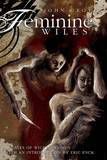 Blu Phi’er Publishing / March 2009
Blu Phi’er Publishing / March 2009
Reviewed by: Vince A. Liaguno
The notion of women as victims in the horror genre is as commonplace a cliché as the deranged redneck or the debonair vampire. So props to John Grover right off the bat for infusing some much-needed female empowerment into the mix with Feminine Wiles, a collection of sixteen short stories in which damsels become devils, victims become villains, and ladies become lethal. There are no cowering wallflowers or wide-eyed virgins to be found here – only wicked women hell-bent on wrecking havoc on their (mainly) male counterparts.
The female baddies here run the gamut from horror tropes (witches, spider women, melodious muses, Medusa-like gals who can turn a man to stone) to genuine innovation (well monsters with maternal instincts, a resurrected Mayan queen who gives new definition to the idea of toxic dust, and Wiccan-worshipping lesbians out for matrimonial revenge – that may just bring back memories of Dynasty’s infamous Moldavian Massacre back in the 80’s for those old enough to remember the heydays of TV camp).
Standouts in the collection include “The Bride Wore Red” (the aforementioned lesbian revenge tale that screams Tarantino), “Excavation” (the risen Mayan queen tale), and “No Man’s Land, a clever take on the wayward traveler tale involving a stranded motorist and creepy triplets that calls to mind the Grand Guignol 70’s spectacle of Terror at Red Wolf Inn. Also noteworthy is the shortest piece in the collection, “Playing with Dolls”, which evokes the Dad-took-away-my-comic-books connecting narrative from Creepshow.
But while Grover nobly attempts to free the female horror figure from her clichéd chains, he also reinforces a few stereotypes along the way – particularly in the case of physical attributes. At least half of the lady killers here are described in full-on romance novel cliché – long black/red/blond hair, slender/sumptuous curves, ample/full breasts, sensuous/alluring/piercing eyes, full red lips, flowing robes/dresses/gowns. As a result, Grover misses more than one opportunity to craft distinctive, three-dimensional villainous women, instead presenting the literary equivalent of Barbie dolls with really bad attitudes.
Grover’s stories – while respectably competent in their overall execution – are overwrought at times with metaphor and generally lacking in narrative adventurousness. Only “The Bride Wore Red” strays from his formula here, beginning at the end and ending at the beginning. Otherwise, it’s a basic story structure employed throughout much of the collection: Male/two males enter setting (old house/sewer/ attic/dark forest), encounter villainess who explains her origin, succumbs to/defeats villainess, hint that story’s not quite over. End credits.
As a whole, the collection feels like a half-baked pie, leaving the reader with the idea that another 20 minutes in the oven would have browned the crust a bit more, cooked the ingredients all the way through. Thankfully, there are enough tasty bites (“No Man’s Land”, “Playing with Dolls”, “Excavation”, and “The Bride Wore Red”) amongst the undercooked bits to keep it all down without suffering from literary reflux.
Purchase Feminine Wiles by John Grover.
Wolf’s Gambit / W.D. Gagliani
 Leisure Books / September 2009
Leisure Books / September 2009
Reviewed by: Joan Turner
Legends of the were-wolf have existed throughout recorded history. The image of the man-wolf was first inscribed on a cave wall, and written accounts date back to the Biblical story of King Nebuchadnezzar (Daniel 4:15-33). According to Greek mythology, an offended Zeus transformed King Lycaon of Arcadia into a wolf after he served the god a meal of human flesh.
Long a staple of horror fiction, W. D. Gagliani has fused horror with crime fiction to more than breathe new life into the traditional werewolf tale. He has produced a contemporary Wolf Cycle that is nothing short of a no-holds-barred thrill ride. Second in the series and sequel to Gagliani’s 2004 Bram Stoker nominated novel Wolf’s Trap, Wolf’s Gambit is a lusty page-turner packed with murder, mystery, sex, and unpredictable plot twists that keep the reader on the edge of his seat while tension mounts.
Wolf’s Gambit continues the story of Nick Lupo, a troubled city detective infected with the werewolf curse in his youth. Once a month, when the full moon brings out the Creature in him, Lupo heads for his secluded cabin in the North Woods where he can release the beast within and set it free. There, his girlfriend, the reservation doctor, Jessie Hardin, waits.
But trouble is waiting also. A series of brutal murders on the reservation that seem linked to the construction of a new casino have taken place. At first, it appears that an animal is responsible for the attacks, or a human who wishes to disguise the killings as such, but Lupo soon discovers that others of his kind are to blame. He and the doctor set out help the local sheriff and stop the killers at any cost.
Superb characterization brings protagonists and villains to life in this desperate game of survival. Werewolves, war-hardened mercenaries and a mystery man with an evil agenda of his own combine to build suspense to nail-biting proportions with every plot twist as Gagliani takes the crime story to a completely new level. Prepare for the unexpected.
Built on strengths – not weaknesses – shortcomings in this novel are few. Some readers may find the hero’s name, Lupo, a bit obvious, but the author provides a plausible explanation for that, and the story leaves the reader with a few unanswered questions and a hunger for more. Fortunately, the third installment in the series, Wolf’s Bluff, scheduled for release in 2010, takes up where this novel ends.
Wolf’s Gambit is one of the most powerful lycanthrope novels to come out of the horror genre in decades and one no fan of werewolf lore will want to miss. Fantastic!
Purchase Wolf’s Gambit by W.D. Gagliani.
Writers Workshop of Horror / Edited by Michael Knost
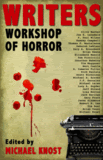 Woodland Press / August 2009
Woodland Press / August 2009
Reviewed by: Rich Ristow
Books on writing generally fall into two categories: inspirational or practical. Unfortunately, a lot of what’s available falls into the “inspirational” camp – short on real advice, but heavy on the “Yes, You can do it!” fuzzy-wuzzies. They have the feel and tenor of self-help books like: Yes, You Can Thwart Crippling Depression! or How To Come Out of a Shame Spiral Without A Case of the Dizzies! or It Doesn’t Matter What You Do, Just Do It With Exclamation Points!
Sarcasm aside, some people need inspiration to write. Besides, it’s not my aim to demean all self-help writers. The more well-written of those guides do serve a purpose. Obviously, book sales speak volumes, and there is a dedicated market for that genre. When it comes to writing, however, it strikes this reviewer as sad that people would dole out money for flaccid, vapid inspiration. Don’t these people have teachers, relatives, friends, or loved ones? Not even the blind love of a dog, or the skeptical affection of a cat? Self-help books, at their worst, most poorly written, come off as a cynical attempt to profit off the emotionally needy. Aspiring writers need the hard truth: publishing is a cold place, one where a prospective editor probably doesn’t give a rat’s ass about your feelings. That prospective editor likely has a hundred other crappy things to read in their slush pile. So, Chicken Soup for the Writer’s Soul may make one feel all squishy inside, but it’s not going to give practical guidance in how to write better stories.
Sure, I’ve painted a bit of an extreme here, but I’ve discovered how valuable real how-to books are. Michael Knost’s Writers Workshop of Horror is one of those real how-to books – just like Gerald Stern’s Making Shapely Fiction or David Madden’s Revising Fiction. While those two focus on fiction in general, Knost’s book offers what the title suggests: a specific discussion of how to write horror. Knost has amassed an impressive cast of contributors to do just that.
Writers Workshop of Horror functions as a platform for proven horror writers with lengthy bibliographies. Each, in their own way, tackles a certain compositional issue, quite often through the lens of their own work and creative process. J.F. Gonzalez, for example, relates how, on a recent collaboration, he was charged with writing the end of a novella. From there, he moves into a discussion about how many horror writers create the end of their story and work backwards, figuring how their characters may have come to their tragic ends. Gary Braunbeck sifts through issues of emotion, relating the act of writing to the craft of acting. One could go on, naming contributors like Clive Barker, Joe R. Lansdale, Michael Arnzen, Ramsey Campbell, and many more. One could try and rate each individual contribution, but for a reviewer that would be inherently foolish.
Educational jargon has a term: learning style. Everybody has one, and it’s unique to their personality, upbringing, and worldview. People learn differently by different methods, so one’s way of acquiring knowledge and understanding may not work for others. In short, Rick Hautala’s, F. Paul Wilson’s, or anybody’s practical advice will speak to some people more than others. This is natural and to be expected. However, there is something in the Writers Workshop of Horror for everybody.
Will this book make you a better writer? Absolutely not. Brian Keene, both in Writers Workshop of Horror, and across the Internet, has long maintained that the only thing that makes writers better is...wait for it...writing. It comes down to something he has described as, to paraphrase: “Ass in chair, fingers on keys.” And he’s correct. A writer can have all the greatest tools and blueprints handed to him and still turn out bad fiction. Improving one’s writing comes with experience; the old adage is: the more you put words onto paper or a computer screen, the better you get. Sure, there are other factors involved, like reader response and constructive criticism. Experience just works that way. However, when your ass is in the chair, and your fingers are on the keys, it doesn’t hurt to have few good manuals and resources a reach away. Writers Workshop of Horror is destined to be one of those invaluable resources.
Purchase Writers Workshop of Horror, edited by Michael Knost.
The Shimmer / David Morrell
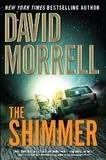 Vanguard Press / July 2009
Vanguard Press / July 2009
Reviewed by: Blu Gilliand
In Marfa, Texas, people have reported seeing strange lights dance and swirl on the horizon. No one can explain where they come from, although theories ranging from radioactive gasses to static electricity have been floated. Similar lights have been seen in remote parts of Norway, Thailand, and Australia. Like those in Marfa, not everyone who seeks them finds them, and no one can explain them.
While the above information, which can be verified through hundreds of reports on the Internet, may seem like nothing more than a small item to stash in one’s “strange but true” file, it has become much more in the hands of master thriller writer David (First Blood, Creepers, Scavenger) Morrell. It’s become the basis for his new book, The Shimmer, a fast-as-lightning read that’s one of the most entertaining books of the summer.
In The Shimmer, the lights appear in the tiny town of Rostov, Texas. The town has made some meager attempt to cash in on the phenomenon, putting up a small observation area near the site of the lightshow. People gather there every night, some out of curiosity, some out of an irresistible calling that is beyond their ability to explain. And even when the lights appear, not everyone present sees them.
It is at this observation deck that Santa Fe police officer Dan Page finds his wife, Tori, after she leaves their home with no explanation. The relationship between the two is complicated, more so than even Dan realizes until the events in Rostov, and their attempts at reconciliation play out in a nice touch of realism against the backdrop of mayhem that arrives with the lights.
Morrell weaves several plotlines throughout the book: the military’s interest in the lights, an interest which threads back through many years and through three generations of one family; Rostov’s struggle to maintain order amid the chaos the lights invoke; an ambitious journalist’s determination to ride the story all the way to one of the major networks; and, as mentioned above, Dan Page’s struggle to save his wife and, ultimately, his marriage. Morrell juggles these different parts with an expert’s finesse, never dwelling on one so long that we lose track of what’s going on with the others. Each plotline builds and builds until everything dovetails in an action-drenched climax that’s over before you know it.
As for the lights themselves, Morrell wisely never discloses much about them. They are as much a mystery by the last page as they were on the first. And while the major plot points all reach some kind of resolution, the thing that drew them all together – those mysterious, shimmering balls of color that come out on some nights to dance – those are still out there, waiting for the characters, the authors and the readers to maybe one day come to watch them again.
Purchase The Shimmer by David Morrell.
As Fate Would Have It / Michael Louis Calvillo
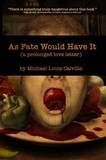 Bad Moon Books / 2009
Bad Moon Books / 2009
Reviewed by: Anthony J. Rapino
As Fate Would Have It, Michael Louis Calvillo’s second novel, is a perfect example of ambitious horror, striving to exhibit dark fiction’s literary capabilities while boasting its ability to plumb the depths of the human animal. Calvillo’s unique style and penchant for allusion emulsifies into brilliant vinaigrette: sweet, a little sour, and just a touch bitter.
As with I Will Rise – Calvillo’s first novel – As Fate Would Have It opens on a main character the reader has no reason to like. Montgomery is a murderer and a cannibal. He lures women back to his house so he can kill them, butcher them, and eat them. And yet, somehow, Calvillo manages to elicit – if not adoration – a certain sympathy for this flawed and evil character. He plays on our sympathies by portraying Montgomery as a charmingly goofy chef who is successful and talented. Sure, he murders people and eats them. But these actions are justified; besides, he doesn’t enjoy killing.
Montgomery is years into his culinary addiction, a cannibalistic lifestyle both he and his girlfriend, Liz, enjoy. But he’s starting to feel guilty, and after killing a young beauty named Heather, he decides it’s time to quit. A resolution he knows Liz will not favor.
Meanwhile, as days pass, Heather’s best friend Ashley worries something terrible has happened; it’s not like Heather to disappear without a word. While Ashley has a lingering sense that Montgomery – the last person Heather was with – is to blame for the disappearance, her dependence on heroine keeps her from making significant headway in the would-be investigation. If only she can break from her habit long enough to confront Montgomery, she may be able to discover what happened to her friend.
Much of the novel is spent drawing parallels between addiction and love. On one side we have Montgomery and Liz, who are addicted to human flesh. On the other side are Ashley and her boyfriend Henry, who are addicted to heroin. As Montgomery and Ashley try to quit their respective obsessions, the withdrawal symptoms and relationship woes are all too similar, leaving room for reader comparisons.
The concept of fate also runs throughout the novel like a thread. Are the characters at fault for their addictions, or were they simply playing the hands they were dealt? While Calvillo doesn’t try to answer this question for us, he does show us all the cards in play so we can make up our own minds. We know the events that led to Montgomery’s peculiar fixation, as well as those surrounding Ashley’s addiction. Was it their fault — or is fate to blame?
As Fate Would Have It is a layered, complex read with gore enough for any horror fan and literary prowess enough for any scholar. Don’t wait for fate to drop a copy in your lap; buy it today.
Purchase As Fate Would Have It by Michael Louis Calvillo.




